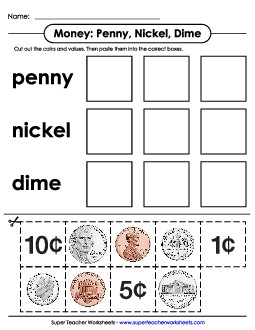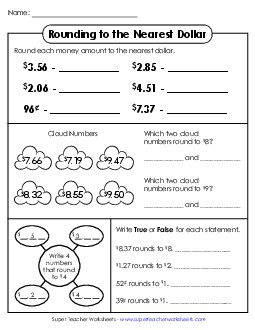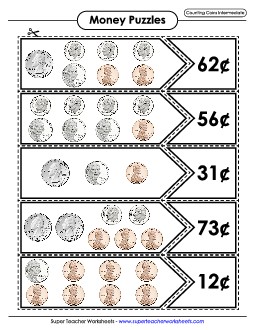Money Worksheets

Learn to identify coins, coin names, and their values. This page has free worksheets, task cards, as well as cut-and-glue activities.
example: What coin is this? Quarter.
This page will have students counting sets of pennies only, nickels only, dimes only, and/or quarters only. These basic-level activities are designed primarily for students in Kindergarten and 1st grades.
example: Three nickels. How much money is shown? 15 cents.
Print worksheets and games on counting mixed coins. This page features basic level activities best suited for students in 1st and 2nd grade.
example: 1 nickel and 3 pennies. How much money is shown? 8 cents.
Here are some more advanced worksheets on counting mixed coins. These were designed for students in 2nd through 4th grades.
example: 2 quarters, 5 dimes, six nickels, and two pennies. How much money is shown? $1.62
This page has worksheets split up into 3 groups: counting money up to $4.00, counting money up to $12.00, and counting money up to $50.00. There are some free money worksheets to try in your class!
example: 2 twenty dollar bills, 6 quarters, and 7 nickels. How much money is shown? $41.85
With these worksheets, students can practice making change. Includes task cards, word problems, and other printables.
Adding MoneyPractice adding money amounts with these free printable money worksheets, task cards, and games.
Subtracting MoneyPrint out these files to supplement your lessons on subtracting money and using subtraction to make change. Includes worksheets, a 'magic digits' game, and task cards.
Multiplying MoneyMultiply money amounts by 1-digit numbers. THis page has a worksheet generator tool, as well as pre-made worksheets, puzzles, and task cards.
Comparing and Ordering MoneyUse the mathematical symbols for greater than, less than, and equal to to compare money amounts.
Rounding: Money to Nearest Dollar & Nearest DimeWith these activities, students will learn to round money amounts to the nearest dollar or the nearest ten cents.
Rounding: Next Dollar UpUnlike regular rounding, on these worksheets students will always round up to the next dollar to determine how many bills are needed. For example, a t-shirt costs $6.29. You'd round up and give the cashier $7.
Counting Money: AustralianThese printable worksheets and games have Australian coins and banknotes on them.
Counting Money: CanadianThis page will have students counting Canadian toonies, loonies, quarters, dimes, and nickels. Most worksheets do not include pennies.
Counting Money: United KingdomCount British pounds. Banknotes and coins include £2, £1, 50p, 20p, 10p, 5p, 2p, and 1p coins. Includes task cards, worksheets, and class games.



Learning about money and practicing money skills is an essential part of elementary school math, typically introduced in first or second grade and reinforced in the following years. This topic helps students understand the value of different coins and bills, how to count money, and how to make change - crucial skills for both mathematical development and real-world financial literacy. By teaching children to recognize and calculate with different denominations, students learn the foundations of financial responsibility, while also strengthening their addition, subtraction, multiplication, and division skills.
In the classroom, teachers often use hands-on activities to make learning about money engaging and practical. Many classrooms use play money or real coins and bills in exercises where students can practice counting and making change in simulated scenarios, such as running a classroom store. Visual aids like coin charts, matching games, and interactive apps that simulate financial transactions are also effective for reinforcing these skills. Word problems involving money allow students to apply their mathematical knowledge to everyday situations, helping them understand the real-life relevance of what they are learning.
Understanding money is crucial not only for academic success but also for developing essential life skills. Proficiency in counting money and making change fosters critical thinking and problem-solving abilities, which are key in both mathematics and daily activities. Additionally, having a solid grasp of money concepts prepares students for financial independence later in life, helping them to budget, save, and spend responsibly. By mastering money skills early on, students are better equipped to navigate the world around them, both in the classroom and beyond. Super Teacher Worksheets provides hundreds of printable worksheets specifically designed to help children learn all about money.






